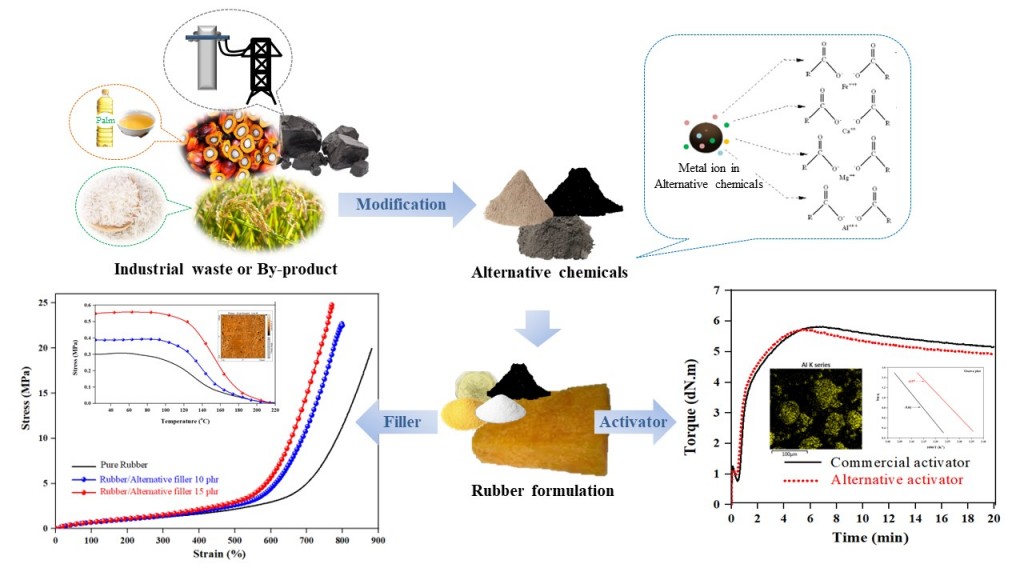Education:
- B. Sc. (Rubber Industry Management) Prince of Songkla University, Thailand
- Ph. D. (Rubber Technology) Prince of Songkla University, Thailand
Research interests:
1) Rubber Composites
2) Alternative chemicals for rubber
Natural rubber (NR) is a green polymer and the main economic crop of Thailand. It has been used as material for several applications. For the specific applications, NR needs to be mixed with fillers to improve the drawback of NR. The most important fillers for rubber industry are conventional synthetic fillers as carbon black and silica. However, the production of these conventional fillers is highly energy-consuming. Therefore, alternative fillers from renewable resources are considerable interest to use in the rubber industry for multiple purposes, including reinforcement, improved processing, and reduced material costs.
Recently, I have applied fly ash from power plant as alternative filler and activator for rubber composites. It was found that it enhanced the cure characteristics and mechanical properties of the NR vulcanizates. In addition, faster curing was observed because of acceleration by the metal oxide impurities in fly ash. Mechanical properties increased with the addition of fly ash due to the physical and chemical interactions of filler and rubber molecules.
My interest now focuses on applying of industrial wastes or by-products such as fly ash, and other wastes from industry (i.e., rice husk ash, oil palm ash, plastic waste), and various natural fibers as alternative chemical or matrix to reduce or replace commercial chemicals and matrix in polymer composite.
Publications:
- Yangthong, H., Nun-Anan, P., Krainoi, A., Chaisrikhwun, B., Karrila, S., & Limhengha, S. (2024). Hybrid Alumina–Silica Filler for Thermally Conductive Epoxidized Natural Rubber. Polymers, 16(23), 3362.
- Yangthong, H., Buaksuntear, K., Suethao, S., Chworos, A., & Smitthipong, W. (2023). Waste material fly ash as an alternative filler for elastomers. Polymer Engineering & Science, 63(8), 2624-2644.
- Limhengha, S., Chueangchayaphan, N., Karrila, S., Madmaeroh, N., & Yangthong, H. (2023). Properties and cost of natural rubber latex foam using biomass ash filler from agarwood pellets. BioResources, 18(3), 5585.
- Faibunchan, P., Yangthong, H., Nun-anan, P., Karrila, S., & Limhengha, S. (2022). Effects of processing parameters on the properties of fully bio-based poly (butylene succinate-co-adept) and epoxidized natural rubber blend filled with agarwood waste: A taguchi analysis. Polymer Testing, 107, 107497.
- Yangthong, H., Nun-anan, P., Faibunchan, P., Karrila, S., & Limhengha, S. (2021). The enhancement of cure and mechanical properties of natural rubber vulcanizates with waste Aquilaria crassna wood. Industrial Crops and Products, 171, 113922.
- Yangthong, H., Pichaiyut, S., Wisunthorn, S., Kummerlöwe, C., Vennemann, N., & Nakason, C. (2020). Role of geopolymer as a cure activator in sulfur vulcanization of epoxidized natural rubber. Journal of Applied Polymer Science, 137(17), 48624.
- Yangthong, H., Wisunthorn, S., Pichaiyut, S., & Nakason, C. (2019). Novel epoxidized natural rubber composites with geopolymers from fly ash waste. Waste Management, 87, 148-160.
- Yangthong, H., Pichaiyut, S., Jumrat, S., Wisunthorn, S., & Nakason, C. (2019). Mechanical, thermal, morphological, and curing properties of geopolymer filled natural rubber composites. Journal of Applied Polymer Science, 136(15), 47346.
- Yangthong, H., Pichaiyut, S., Jumrat, S., Wisunthorn, S., & Nakason, C. (2018). Novel natural rubber composites with geopolymer filler. Advances in Polymer Technology, 37(7), 2651-2662.

